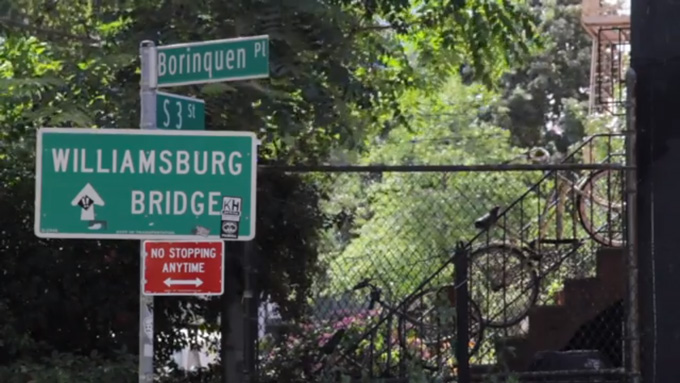
Still from Toñita’s, directed by Beyza Boyacioglu and Sebastian Diaz, 2013.
Few venues have endured the transformation of South Williamsburg, Brooklyn from a mostly Hispanic neighborhood ravaged by gang violence and drugs into one of the hippest places in New York. As harsh gentrification began to clear Los Sures (“South Side”) of poverty and crime in the 1990s (a process that accelerated with the 2005 rezoning of Williamsburg and Greenpoint), it also washed away the majority of the Puerto Rican community—and with it, the neighborhood’s local identity and culture. Today, the Caribbean Sports Club, which has remained open for over 40 years thanks to its owner and community matriarch Maria Toñita, is the only remaining Latino social club in the neighborhood.
Amid the carefully stylized cafés and bars of Williamsburg, The Caribbean (also fondly labeled “Toñita’s”) stands out for its makeshift quality and homelike decoration. Stepping into the club for the first time, it is impossible not to be struck by this atmosphere. Sitting down to enjoy a two-dollar Corona, as Afro-Cuban and Caribbean rhythms pour out from the jukebox, you get a chance to observe the interactions among regulars and gaze at the pictures on the wall. Only then do you begin to understand what The Caribbean actually is. The magic of this place comes from relationships that have developed over decades, as the photographs of weddings, birthdays and domino and baseball games accumulated on its walls attest. The club preserves the collective memory of the Puerto Rican community as its history is being erased from the South Side’s streets.

Still from Toñita’s, directed by Beyza Boyacioglu and Sebastian Diaz, 2013.
My partner, Sebastian Diaz, and I began spending time at The Caribbean in early November 2012. We were fascinated by this Latino social club resisting the brutal gentrification of Williamsburg. We decided to make a short documentary that dives into The Caribbean as a microcosm for our questions about urban space, displacement and identity. When we began filming in February, we aimed to convey the joy and liveliness of the club; the film was our love letter to Brooklyn’s beautiful Nuyorican culture. In addition, we wanted to unravel the story of the owner Maria Toñita, who was at the club every day, sitting at her corner with her usual look of serenity, colorful outfits and jewel-covered fingers.
It was amazing to see how everyone gravitated toward Toñita at The Caribbean, despite her seemingly reserved personality. She was a recurring subject in the interviews with regulars, who were grateful for her persistence in keeping her “Latin corner” open even though it didn’t provide her much financial support. Toñita’s selfless initiative has effectively preserved this local community, yet she has always managed to remain modest and giving. The following clip from Toñita’s shows something of the atmosphere and customs of the club, including the weekly serving of free food cooked by Toñita.
Excerpt from Toñita’s, directed by Beyza Boyacioglu and Sebastian Diaz, 2013.
During the months we spent shooting at The Caribbean and collecting testimonies, we were surprised to hear the club’s regulars express contentment with the transformation of Los Sures. When we brought up the history of the neighborhood, many seemed to have a love-hate relationship with its notorious past. Even though they didn’t deny their longing for the good old days when Los Sures was like a large and close-knit Hispanic family, they also expressed pride about how the neighborhood has turned out, with today’s designer boutiques, flea markets, beautiful cafés and gourmet restaurants. This was surprising to us; we anticipated that the old-timers would be bitter about the dissolution of their community, the arrival of condos and the new, predominantly white residents. Occasionally, some anger revealed itself when we persisted in our questioning. Staying true to their ambivalent testimonies, we refrained from reducing the narrative to a simplistic story of the ills of gentrification. The old-time residents’ relationships with the new Williamsburg was much more complex. In the next clip, two club regulars share their opinions about the South Side’s past and present.
Excerpt from Toñita’s, directed by Beyza Boyacioglu and Sebastian Diaz, 2013.
Toñita’s is part of Living Los Sures, a UnionDocs collaborative production.

